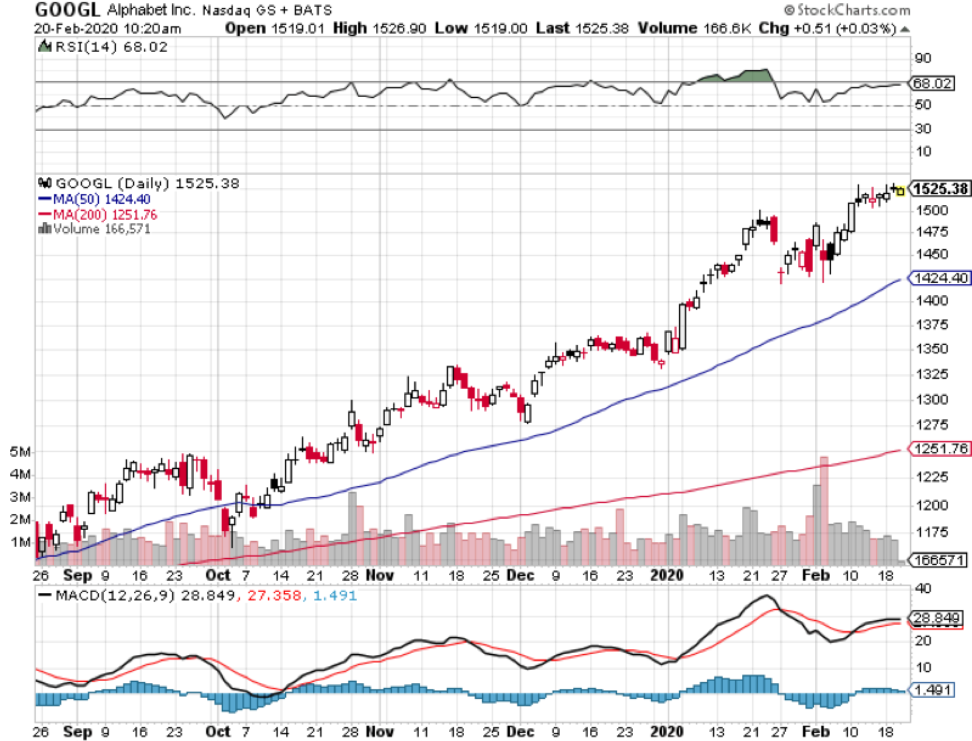When John identifies a strategic exit point, he will send you an alert with specific trade information as to what security to sell, when to sell it, and at what price. Most often, it will be to TAKE PROFITS, but, on rare occasions, it will be to exercise a STOP LOSS at a predetermined price to adhere to strict risk management discipline. Read more
When John identifies a strategic exit point, he will send you an alert with specific trade information as to what security to sell, when to sell it, and at what price. Most often, it will be to TAKE PROFITS, but, on rare occasions, it will be to exercise a STOP LOSS at a predetermined price to adhere to strict risk management discipline. Read more
Like a lot of stocks today, ZEN is oversold.
Because of this, I am going to suggest you close the position and book a small profit.
Here is how you close the deal.
Sell to Close (1) March 20th - $87.50 call @ $2.90. The 1 call will net $290.
Sell to Close (2) March 28th - $87.50 put @ $3.80. The two puts will net $760.
The credit will be about $1,050 based on the position size I suggested yesterday.
The gain will be about $90 for one day.
Global Market Comments
February 21, 2020
Fiat Lux
Featured Trade:
(ON EXECUTING MY TRADE ALERTS),
(TEN REASONS WHY STOCKS CAN’T SELL-OFF BIG TIME),
(SPY)
From time to time, I receive emails from a subscribers telling me that they are unable to get executions on trade alerts that are as good as the ones I get.
There are several possible reasons for this:
1) Markets move, sometimes quite dramatically so. That’s why I include a screenshot of my personal trading account with every trade alert to reliably source the price for the readers.
2) Your Trade Alert email was hung up on your local provider’s server, getting it to you late. This is a function of your local provider’s lack of adequate capital investment and is totally outside our control.
3) The spreads on deep-in-the-money options spreads can be quite wide. This is why I recommend readers to place limit orders to work in the middle market. Make the market come to you. Never buy at market or pay the offered side of the market.
4) Hundreds of market-makers read Global Trading Dispatch and many have attached algorithms to my service. The second they see one of my Trade Alerts, they adjust their markets accordingly.
This is especially true for deep-in-the-money options. A spread can go from totally ignored to a hot item in seconds. I have seen daily volume soar from 10 contracts to 10,000 in the wake of my Trade Alerts.
On the one hand, this is good news, as my Trade Alerts have earned such credibility in the marketplace, with a 90% success rate. On the other hand, it is a problem for readers encountering sharp elbows when attempting executions in competition with market makers.
5) Occasionally, emails just disappear into thin air. This is cutting-edge technology, and sometimes it just plain doesn’t work.
This is why I strongly recommend that readers sign up for my free Text Alert Service as a backup. Trade Alerts are also always posted on the website as a secondary backup and show up in the daily P&L as a third. So, we have triple redundancy here.
The bottom line for all of this is that the prices quoted in my Trade Alerts are just ballpark ones with the intention of giving traders some name-picking and directional guidance.
You have to exercise your own judgment as to whether the risk/reward is sufficient with the prices you are able to execute yourself.
Sometimes it is better to pay up by a few cents rather than miss the big trend. The market rarely gives you second chances.
Good luck and good trading.
John Thomas
Unfortunately, IRBT did the worst thing possible for buyers of options. And that is, it did nothing.
I suggested the trade based on the fact that I thought it would follow through to the upside, but that has not happened.
And with the stock trading right around our strike price, going into the last week of expiration, the options will lose time value.
I would prefer to recoup some of the investment.
Let's go ahead and close the deal.
Sell to Close (2) February 28th - $52.50 calls @ $1.10. The 2 calls will net $2.20
Sell to Close (1) February 28th - $52.50 put @ $2.20
The total credit will be $4.40 per straddle.
The total debit when initiated was $7.30 per position, resulting in a loss of $2.90 per straddle.
Based on the suggested 2 lot, the loss will be $580, or under 1% of the nominal portfolio.
While the Diary of a Mad Hedge Fund Trader focuses on investment over a one week to a six-month time frame, Mad Day Trader, provided by Bill Davis, will exploit money-making opportunities over a brief ten minute to three-day window. It is ideally suited for day traders, but can also be used by long-term investors to improve market timing for entry and exit points. Read more
Mad Hedge Technology Letter
February 21, 2020
Fiat Lux
Featured Trade:
(WHY THE GOVERNMENT IS GUNNING FOR GOOGLE AND FACEBOOK)
(FB), (GOOGL), (TWTR), (ADBE), (FTNT), (EBAY)
Google (GOOGL) and Facebook (FB) are dominant to the extent that the U.S. administration is hoping to dismantle them.
The two companies enjoy a flourishing duopoly and guzzle up digital ad dollars.
Governments around the world are scratching their heads attempting to figure out how to put a dent in these fortresses and so far, have been unsuccessful.
Big tech has made governments look bad, to say the least, and their response has been even more shambolic.
Alphabet installed Google CEO Sundar Pichai as the top decision-maker for all Alphabet assets preparing for the onslaught of digital privacy headwinds and regulation that the E.U., U.S., and everyone else will throw at them.
Luckily, they do not need to deal with the Chinese communist party as big tech minus Apple was effectively banned years ago.
What’s on Google and Facebook’s plate right now?
Attorney General William Barr has pointed the finger at these two platforms for hiding behind a clause that gives them immunity from lawsuits while their platforms carry material promoting illicit and immoral conduct and suppressing opinions.
Barr is currently looking into potential changes to Section 230 of the Communications Decency Act, which was passed in 1996 and has been also referred to as the supercharger to tech riches.
What could eventually come of this?
Barr could decide for the Justice Department to explore ways to limit the provision, which protects internet companies from liability for user-generated content.
This could open up Google and Facebook to higher costs of managing content on their platforms and lawsuits related to malcontent in which they fail to remove.
Even though platforms love to market that they actively thwart bad actors, at the end of the day, they aren’t on the hook for what happens.
Massive alterations could fundamentally weaken their business models and force them to review each word and photo that is thrown upon their platform.
They have already hired an army of hourly paid contractors, but at their massive scale, content is simply impossible to smother.
Content generators understand how to sidestep machine learning algorithms which are based on backdated data, meaning they would not be able to catch a new iteration of past content.
Absolving themselves of any responsibility for policing their platforms has been an important catalyst in the outperformance in shares for both Facebook and Google.
The social side of this has cringeworthy unintended consequences.
The Computer & Communications Industry Association, a tech trade group that counts Google and Facebook as members want the government to stay out of it as they believe they are overreaching.
Government has been slowly making inroads in combatting the strength of these digital platforms, and the first successful foray was when Congress eliminated the liability protection for companies that knowingly facilitate online sex trafficking.
Big tech won’t go with a whimper and they will propose a range of changes to avoid direct damage to their business model such as raising the bar a smidgeon on which companies can have the shield, to carving out other laws negating attempt to weaken their platforms, to delaying the repealing of Section 230.
There is too much shareholder value on the line and as the coronavirus rears its ugly head, it’s ironic that investors perceive safety in not only the U.S. dollar but in the vaunted FANG tech group.
Ultimately, the math wins out and these companies with gargantuan earnings can weather any storm with a moat as wide as ever.
It’s to the point that a $10 billion fine is a massive victory, and what other group of companies can boast about that?
We can only trade the market we have in front of us and not the one we want.
I pulled the trigger on a Google call spread and I believe this narrow group of power tech players and their partners in crime cloud stocks of the likes of Twitter (TWTR), eBay (EBAY), Fortinet (FTNT), Adobe (ADBE), and a few others will hoist the market on its back like I predicted it would at the beginning of the trading year.
Mad Hedge Biotech & Healthcare Letter
February 20, 2020
Fiat Lux
Featured Trade:
(A NEW CURE FOR CANCER)
Legal Disclaimer
There is a very high degree of risk involved in trading. Past results are not indicative of future returns. MadHedgeFundTrader.com and all individuals affiliated with this site assume no responsibilities for your trading and investment results. The indicators, strategies, columns, articles and all other features are for educational purposes only and should not be construed as investment advice. Information for futures trading observations are obtained from sources believed to be reliable, but we do not warrant its completeness or accuracy, or warrant any results from the use of the information. Your use of the trading observations is entirely at your own risk and it is your sole responsibility to evaluate the accuracy, completeness and usefulness of the information. You must assess the risk of any trade with your broker and make your own independent decisions regarding any securities mentioned herein. Affiliates of MadHedgeFundTrader.com may have a position or effect transactions in the securities described herein (or options thereon) and/or otherwise employ trading strategies that may be consistent or inconsistent with the provided strategies.







